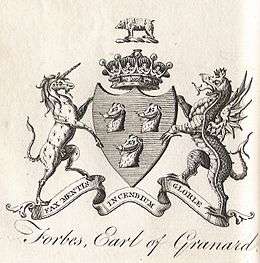George Forbes, 6th Earl of Granard
George Forbes, 6th Earl of Granard (1760–1837), was an Irish general.
Forbes was the eldest son of George Forbes, 5th Earl of Granard, by his first wife, Dorothy, second daughter of Sir Nicholas Borley, baronet, of the Isle of Anglesea, and great-grandson of Admiral George Forbes, 3rd Earl of Granard. He was born on 14 June 1760, he was educated at Armagh. He married, 10 May 1779, Lady Selina Frances Rawdon, youngest daughter of John Rawdon, 1st Earl of Moira, by his third wife, Lady Elizabeth Hastings, eldest daughter of the ninth Earl of Huntingdon. By this lady, who was sister of the first Marquis of Hastings, Granard had nine children. On succeeding to the title, the year after his marriage, he made a lengthened tour on the continent. He was introduced to Cardinal York at Rome, attended one of Frederick the Great's reviews in Silesia, and resided in France and at Vienna. On his return home he devoted himself to politics, and, following the example of Lord and Lady Moira, adopted liberal opinions, and with his votes and interest steadily supported the policy of Charlemont, Grattan, Curran, and other leaders of the liberal party in Ireland. The Marquis of Buckingham referred to him as the most uncompromising opponent of his administration. Granard was appointed a lieutenant-colonel in the army 17 May 1794, and lieutenant-colonel commandant of the 108th foot, an Irish regiment which he raised in November following. The 108th was disbanded at Gibraltar in 1796. Granard also raised the Longford militia, and commanded it at the battle of Castlebar in 1798, where the regiment, which was said to be disaffected, ran away. Lord Cornwallis wrote in highest praise of Granard's gallantry in endeavouring to rally his regiment (Cornwallis Correspondence, ii. 393). He was also present at Ballinamuck, where the French, under Humbert, surrendered to Cornwallis.

Granard displayed the greatest aversion to the union, an opinion from which none of the inducements then so lavishly offered by the government made him swerve, and he was one of the twenty-one Irish peers who recorded their protest against the measure (see ‘Protest of the Irish House of Lords,’ Ann. Reg. 1800, p. 196). Having been deprived of his seat in the House of Lords after the union, he took little part in politics, but devoted himself to the management of his estates, and is said to have been a popular landlord. During the brief administration of ‘All the Talents’ in 1806 he was made a peer of the United Kingdom under the title of Baron Granard of Castle Donington, Leicestershire (the seat of his father-in-law), and was also appointed clerk of the crown and hanaper in Ireland, then a most lucrative office. He became a colonel in the army in 1801, major-general in 1808, and lieutenant-general in 1813. He afterwards resided chiefly in France. He came to England to support both the Roman Catholic Emancipation and Reform Bills, and after the passing of the latter was offered a promotion in the peerage, which he declined, as he had previously refused the order of St. Patrick. He was made full general in July 1830. He died at his residence, the Hôtel Marbœuf, Champs-Elysées, Paris, 9 June 1837, at the age of seventy-seven, and was buried in the family resting-place at Newtownforbes, County Longford, Ireland.
References
![]() This article incorporates text from a publication now in the public domain: "Forbes, George (1760–1837)". Dictionary of National Biography. London: Smith, Elder & Co. 1885–1900.
This article incorporates text from a publication now in the public domain: "Forbes, George (1760–1837)". Dictionary of National Biography. London: Smith, Elder & Co. 1885–1900.
External links
- Hansard 1803–2005: contributions in Parliament by the Earl of Granard